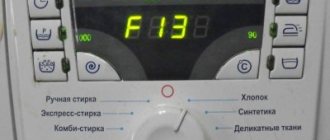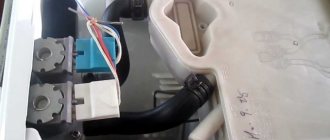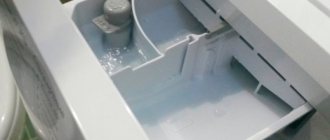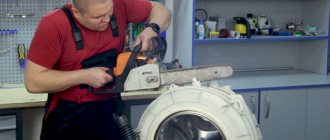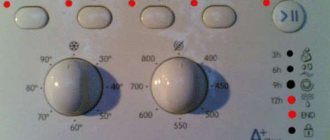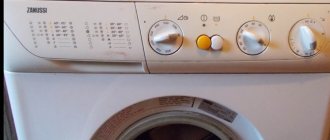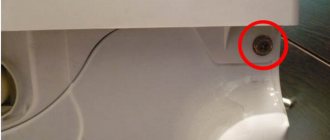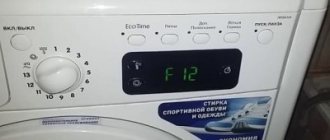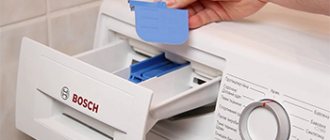Regardless of the model manufacturer, be it LG or Indesit, the washing machine may break down one day. There are different breakdowns, for example, the machine knocks out the plugs, does not heat the water, the device itself gets hot. In any such situation, the owner of the machine must prevent breakdown. Let's take a closer look at the reasons why the washing machine gets very hot.
The washing machine is broken
Why does the washing machine get hot?
Regardless of the model manufacturer, be it LG or Indesit, the washing machine may break down one day. There are different breakdowns, for example, the machine knocks out the plugs, does not heat the water, the device itself gets hot. In any such situation, the owner of the machine must prevent breakdown. Let's take a closer look at the reasons why the washing machine gets very hot.
The washing machine is broken
Why can’t heating up the machine be completely avoided?
No matter how elegant and precise your machine is, don’t forget that it has an electric motor inside. And, if you have a good car, this motor is quite powerful. For example, Mustang clippers produce 5,900 rpm. That is approximately 98 revolutions per second! Yes, yes, this is the very time you need to say “one”.
The knives move at incredible speed. Naturally, they heat up - even with good lubrication, the friction force still remains. And the engine itself, which produces such power, gets hot. This cannot be avoided except by turning off the machine.
But. This does not mean that the machine in your hands has the right to turn into a switched-on iron. The design of the machine must be such that the generated heat is distributed and does not cause discomfort during operation. And if the machine starts to heat up indecently, it means that either the design was not reasonable enough from the start, or something happened to the machine.
Temperature
Sometimes it all comes down to the temperature of the water at which the clothes are washed. After all, one mode provides 30-40°, and the other – up to 95°. In the latter case, the Bosch Max 4, Indesit or LG machine actually heats up noticeably along with the water.
Opening the machine door
If the water does not heat up, then the body of the technical device will not change its temperature at all. Then we can safely say that there are problems with heating the liquid.
Why does the water in the washing machine not heat up?
- Incorrect connection (unauthorized discharge of liquid into the sewer).
- Wrong choice of program due to inattention.
- The heating element (heater) burned out. This could happen due to age, manufacturing defects, short circuit.
- The temperature control sensor is broken.
- The programmer is faulty (microcracks on the track, broken firmware).
If the problem is not the temperature, but the machine gets very hot immediately after purchase, it makes sense to take it under warranty and have it checked or call a repairman to your home. Sometimes the problem is a low-quality product.
The plug gets hot
When it seems that the washing machine is heating up, you need to disconnect it from the power supply. This is very easy to do if you unplug the plug from the socket. What if the owner of the device noticed that not only the top case, but also the wire got hot?
Why does the plug of the washing machine get hot along with the wire?
- Prohibited load. Companies that produce low-quality products provide a minimum safety margin due to load. In such a situation, you will have to change the plug and wire.
- Faulty socket. You should pay attention to the temperature of not only the plug, but also the socket; in this case, the plastic may become charred, and its fastening will noticeably weaken.
- Wiring. Also, the Soviet aluminum cable cannot withstand modern loads, since now a washing machine, TV, hair dryer, iron, computer and other appliances are working simultaneously in the apartment. The wiring simply cannot cope with such a load, so for safety reasons (possible short circuit and fire) it is best to replace it.
How much does SMA consume?
When choosing a washing machine, buyers evaluate it according to a standard set of criteria. Usually they are interested in modes, drum loading, dimensions, loading type, drum illumination and other visible functions. But people are rarely interested in kilowatts. The lower the energy consumption class, the more electricity is spent, the higher the electricity bills. Today, almost all SMAs belong to group A. The exception is devices with a drying function - but here you have to sacrifice savings for the opportunity to receive dry laundry.
Energy consumption can be easily determined by the energy efficiency class. Thus, models A+++ consume 0.13 kWh, and, for example, group C – 0.25 kWh. Power consumption of class A SMA is up to 0.31 kWh. Equipment of groups E, F and G is not used in everyday life. Its consumption is respectively 0.39 and 0.4 kWh.
Electric motor failure
The engine stops working for a variety of reasons. For example, due to the drum of an LG or Indesit washing machine being overloaded with clothes, a change in its power, worn out or “non-original” brushes. The panel heats up - this is why the motor becomes faulty.
If the washing machine engine is heating up, you can smell the wife's characteristic smell of rubber or plastic. Even if the wires do not burn, overheating can be easily checked by lightly touching the motor.
The engine is not repaired; usually it is immediately replaced with a new one. Don't wait until the washing machine starts smoking. In the event that the owner of a piece of equipment discovers that it is heating up, you should call a technician or, if you have the skills, carefully inspect the engine yourself.
Why else do LG or Bosch Max 4 devices overheat:
- short circuit in the control board;
- object hitting heater or motor;
- the contact of the tubular electric heater is burnt;
- short circuit;
- The thermostat has failed.
What to do?
The first step is to carefully inspect the washing machine and turn off the power by disconnecting the plug from the outlet. Now you need to determine the cause of the breakdown, without which the equipment cannot be repaired.
It’s better not to do this yourself, but to trust professionals in their field, especially when:
- the case gets very hot;
- heating temperature is very high;
- The glass of the washing machine is heating up.
After diagnosing, repairing or replacing a faulty part, the technical product will work as before.
Selecting parts yourself sometimes just means wasting money. A beginner cannot always figure out which material is best to choose a part from, which in the end simply won’t fit the machine.
If the washing machine is heating up, there is no need to wait until it smokes. There are many reasons why you may notice that the panel on top or the glass is heated. Any minor breakdown can completely disable the device.
Source
Which class should I choose?
Consumption depends on the amount of laundry loaded, on the set temperature, the selected mode - duration and intensity of washing. On the information labels, the manufacturer indicates the maximum power of the device, which reaches 4 kW.
The indicator is designated by the letter P - it allows you to evaluate the “appetites” of the machine. This is a kind of potential: what she can consume maximum. It turns out that no matter what mode is selected, the device is not able to consume more than the set limit. There is no particular point in buying devices with classes A+++ and A++ - there is little savings, but the overpayment for “high energy efficiency” is significant. The consumption of cars of groups B and C differs insignificantly from analogues of group A.
When choosing a washing machine, you do not have to delve into the characteristics of the electric motor that is installed in it. You just need to inquire about its type and energy efficiency class SMA.
Source
Subscribe to the newsletter
During operation, the electric motor may begin to heat up. This problem should be treated with increased attention, since the winding insulation cannot withstand high temperatures. In most cases, it is designed for normal daily operation within 90-95ºС. Some motors are created using windings for which the critical temperature is 130ºC. If emergency overloads or technological malfunctions occur during operation, the motor will begin to heat up, and the winding insulation will fail as a result. The next stage in the development of the situation will most likely be a short circuit, which will lead to the need for expensive repairs. To prevent this from happening, it is necessary to find out why the electric motor and eliminate the causes. In most cases, this is less expensive than ordering a rewind or buying a new motor.
The main reasons for engine overheating The reasons why an engine may overheat can lie in a variety of planes. The main ones include:
- malfunction of the electric current supply line;
- high workload;
- wear of electric motor brushes;
- shaft misalignment;
- bearing wear or poor lubrication;
- Engine cooling fan malfunction.
You can find out why the electric motor is heating up by turning it on without load. But before that, it’s worth studying the motor’s passport, which indicates the maximum load. If it does not correspond to the actual one, then it is worth trying to reduce the amount of work performed by the power unit. When a motor connected without load works perfectly, the problem is only due to incorrect technological processes. If the engine heats up without load, then the reasons are probably inside the power unit. Some of them are quite easy to fix, for example, if it's all about the fan cooling the rotor. It can become clogged with dust and clean it enough for the operating temperature to become normal again. Basic ways to eliminate engine heating Having found out the cause of engine heating, you should definitely eliminate the malfunction. Otherwise, the service life of the engine can be reduced several times. The most commonly used methods for eliminating heating of electric motors are bearing lubrication, stabilizing the voltage in the network supplying the power unit, and removing dust and dirt from the surface of the winding. If the voltage cannot be equalized, then the load on the engine should be reduced. Normal operation of the motor is possible only if the voltage is at least 80% of the rated voltage. More complex causes of motor heating are eliminated in specialized workshops, where brushes are cleaned or replaced, and new motor windings are made. What to do if the electric motor bearing gets hot? For normal operation, care must be taken to keep it clean. Make sure the bearing caps are tightly closed. If they opened due to strong vibration, then dust, dirt or debris probably got into them. For further operation of the bearing, it is necessary to remove the contaminated lubricant, thoroughly rinse the part with kerosene, and blow with compressed air. After this, it is necessary to fill the bearing with lubricant - one that corresponds to the speed of the engine. It is added in small portions using special devices. You cannot overdo it with the amount of lubricant, since sliding in this case will be difficult and the electric motor will again experience increased load.
Source
Reasons for engine heating
If the owner sees that the washing machine motor is overheating, there are quite a few initial reasons. Not in every case is overheating associated with improper operation of the device. Any machine is subject to the negative influence of time, the component parts of the mechanism gradually fall out of working condition, the main engine components wear out, as a result of which the device heats up.
All modern washing machines use a special electronic device to control the system, which requires certain operating skills. To diagnose the engine system, a special test bench is required. Testing functionality without it is impossible. But much greater difficulties are caused by the procedure associated with the direct drive motor, as in some LG brand models. The difficulty is that it is part of a whole mechanism. Repair work requires removal of the entire tank structure. Engines also require an equally complex control system.
Electronic motors will not cause any difficulties in testing. In most cases, there is a malfunction in the operation of the stator, sections of which may not work in harmony, which causes interference.
Problems with the electronic component of the machine
Malfunctions in the operation of the stator are also common. When windings break or short circuits, several characteristic defects appear:
- Complete engine shutdown
- Power reduction
- Heating and detachment of lamellas (by the way, this is one of the “diseases” of Bosch washing machines)
What to do if the washing machine motor gets hot. It is necessary to monitor the functionality of the temperature sensor. In most cases, developers place it at the bottom of the car or on the back side. The location of the sensor near the tank allows for immediate removal. You should carefully remove the part from the mechanism by disconnecting the wires. Next, the resistance is checked, the test is carried out using a tester. Immediately before measuring, immerse the part in warm water. If there is a slight change in resistance, it should be concluded that the thermostat is faulty.
In the event of a short circuit, the electronic circuit of the machine also heats up. It is necessary to inspect the wiring for the presence of sticking or burnt parts of the insulation.
If you cannot detect the above violations, then you need to seek help from a repair company, for example ours: washing machine repair Ufa. High-quality repair of damaged equipment requires special skills. In the absence of the required knowledge, it is impossible to repair a burnt-out device microcircuit. Professionals in their field are able to quickly and efficiently repair the device, while the owner will be able to protect himself from negative consequences when repairing the machine.
Grounding a washing machine, how to do it in a city apartment or country house. Is it possible to connect a washing machine without grounding? What is an RCD?
What to do if the washing machine washes with cold water? What could have caused this and how to fix it?
What could be the reason for a washing machine not draining? How difficult is it to deal with this problem? What kind of breakdown could this indicate, and who should I contact if the breakdown cannot be fixed by myself?
The main causes of problems with water supply to the washing machine and how to eliminate them
Useful article for us purists: “Cleaning a washing machine with citric acid”
Why does the electric motor get hot and how to eliminate the heating?
During operation, the electric motor may begin to heat up. This problem should be treated with increased attention, since the winding insulation cannot withstand high temperatures. In most cases, it is designed for normal daily operation within 90-95ºС. Some motors are created using windings for which the critical temperature is 130ºC
. If emergency overloads or technological malfunctions occur during operation, the motor will begin to heat up, and the winding insulation will fail as a result. The next stage in the development of the situation will most likely be a short circuit, which will lead to the need for expensive repairs. To prevent this from happening, it is necessary to find out why the electric motor is heating up and eliminate the causes. In most cases, this is less expensive than ordering a rewind or buying a new motor.
The main causes of engine overheating
The reasons why an engine may overheat can lie in a variety of planes. The main ones include:
- malfunction of the electric current supply line;
- high workload;
- wear of electric motor brushes;
- shaft misalignment;
- bearing wear or poor lubrication;
- Engine cooling fan malfunction.
Find out why the electric motor is heating up
, you can turn it on without load.
But before that, it’s worth studying the motor’s passport, which indicates the maximum load. If it does not correspond to the actual one, then it is worth trying to reduce the amount of work performed
by the power unit. When a motor connected without load works perfectly, the problem is only due to incorrect technological processes. If the engine heats up without load, then the reasons are probably inside the power unit. Some of them are quite easy to fix, for example, if it's all about the fan cooling the rotor. It can become clogged with dust and clean it enough for the operating temperature to become normal again.
Basic ways to eliminate engine heating
Having found out the reason for the engine heating, it is imperative to eliminate the malfunction
. Otherwise, the service life of the engine can be reduced several times.
The most commonly used methods for eliminating heating of electric motors are bearing lubrication and network voltage stabilization.
, feeding the power unit,
removing dust and dirt from the surface of the winding
. If the voltage cannot be equalized, then the load on the engine should be reduced. Normal operation of the motor is possible only if the voltage is at least 80% of the rated voltage. More complex causes of motor heating are eliminated in specialized workshops, where brushes are cleaned or replaced, and new motor windings are made. What to do if the electric motor bearing gets hot? For normal operation, care must be taken to keep it clean. Make sure the bearing caps are tightly closed. If they opened due to strong vibration, then dust, dirt or debris probably got into them. For further operation of the bearing, it is necessary to remove the contaminated lubricant, thoroughly rinse the part with kerosene, and blow with compressed air.
After this, it is necessary to fill the bearing with lubricant - one that corresponds to the speed of the engine. It is added in small portions using special devices. You cannot overdo it with the amount of lubricant, since sliding in this case will be difficult and the electric motor will again experience increased load.
The original article is posted on our website cable.ru.
If this material was useful to you, please share
them on social networks!
And in order not to miss the release of new articles, click “Like”
and
subscribe
to our channel: Kabel.RF: all about electrics.
Source
Boils laundry and stays hot
And even when your “washing machine” does not boil the laundry, but simply goes astray by 10-20 degrees - the situation, isn’t it, is more than unpleasant. Since washing synthetics, thin fabrics and wool in this situation is simply impossible!
What to do when you determine that your “assistant” is overheating the water?
Laundry is hot after washing
- First, you need to turn off the washing machine. If the machine has finished washing, and you discover the error directly from the damaged items, simply remove the cord from the outlet. When you discover this during the washing process, i.e. noticed that heat is coming from the hatch - it is preferable to stop the washing program.
- Then try to start the drain manager in order to rid the washing machine of hot water, and then unplug the appliance from the outlet. In the event that the machine does not respond - if the control module overheats, it may malfunction - feel free to unplug the washing machine from the outlet and give it a chance to cool.
When the washing machine is empty of laundry and unplugged, it’s time to figure out this problem:
| Breaking | Solution | Cost of repair services |
| Damage to the thermistor (temperature sensor in newer electronically controlled washing machines) | The most common cause of overheating in washing machines with electronic control is inaccurate operation of the thermistor sensor that determines the water temperature. When the water in the machine is heated to the set temperature, the thermistor “signals” this information to the control board. Which, in turn, transmits a command to the heating element relay to turn off the heating. Sometimes it happens that the thermistor begins to malfunction, the cause of which is the formation of scale, and erroneously measures the temperature; in this case, it will be enough to clean the machine using anti-scale agents. But in the vast majority of cases, the thermistor “burns out”, i.e. goes completely out of order. In such a situation, it is necessary to replace the thermistor. | From 1300 rub. |
| Malfunction of the heating element relay (in washing machines with electronic control) | When the water is heated to a given temperature, the thermistor “signals” to the control board, which supplies information to the heating element relay, which turns off the heating. In a situation where the heating element relay does not work, the heating device does not respond to the signal and continues to operate, which leads to overheating and boiling of the water. Heating lasts all the time: if you do not turn off the washing course in a timely manner, the water will heat up during rinsing. |
In this case, the relay needs to be replaced.
Be careful, the table shows approximate prices for the cost of repairs. A specialist will give you a more accurate price for repairing your washing machine after diagnostics. Diagnostic services are provided free of charge; only if you refuse repair services, you will need to pay 400 rubles for calling a specialist.
** The prices in the table are shown only for the work of the master, not taking into account the cost of spare parts.
If you identify a case where your washing machine heats water deviating from the set parameters, do not hesitate! Be sure to seek help from specialists!
Be careful when water overheats
Overheating of water can be dangerous not only for the washing machine, but also for your home, and especially when the water boils in the machine!
Hot water can become a reason for another renovation of the premises, which, naturally, will cause serious damage to the family budget. A Repair Service specialist will arrive at your place within the next few hours, diagnose the washing machine at your home completely free of charge, and then, having received your consent, carry out the necessary repairs. For the comfort of the client, our masters work every day from 8.00 to 22.00, including weekends and holidays. By the way, repairing a washing machine will not take much time - a couple of hours and your “washing assistant” is ready for battle again: heating the water exactly with the specified parameters!
Source
The electric motor gets hot - causes and ways to eliminate them
In a situation where a 220 or 380 V electric motor heats up, it is important to diagnose the problem in time and take measures to eliminate it. If the malfunction is ignored, consequences arise in the form of deterioration in performance and even failure of the unit.
Below we will look at the reasons why the rotor and capacitor heat up, as well as the electric motor of the pump, fan, trimmer and lawn mower. Let's talk about why electric motors burn and what to do if a malfunction is detected.
Contact the professionals
If your machine is faulty, contact a professional. Our specialists have been repairing for many years and are aware of the weak points of AEG models and machines from other manufacturers. We will accurately determine the breakdown and fix it quickly. Our range of services includes:
- free diagnosis of the cause of the breakdown;
- repair or replacement of a failed component;
- preventing the problem from reoccurring;
- providing a guarantee for any repairs.
If the washing machine overheats the water, this can negatively affect the quality of the laundry. For example, items made of wool and cotton in this case shrink and shed very easily, which negates the convenience of wearing and using them.
Every modern washing machine has several washing programs. Washing at water temperatures of thirty, forty and sixty degrees is considered classic. In this case, washing delicate items in accordance with the established rules should be carried out at a hot water temperature of no more than forty degrees Celsius.
How to tell if your engine is overheating
The temperature of the electric motor is one of the main indicators that requires monitoring during operation. An inversely proportional relationship works here - the lower the operating temperature, the higher the resource.
But it is important to understand that for many electric motors, +100 degrees Celsius is considered the norm. That is why, before drawing conclusions about the malfunction of the unit, it is necessary to take into account the manufacturer’s recommendations.
Temperatures up to +600C are considered normal. If it rises to +70, this is not a problem, but you need to pay attention to the situation and possibly carry out inspection and repair, or improve the cooling of the unit.
When +1000C is reached, it is important to take control of the operation of the electric motor and identify the causes of overheating. If the temperature parameter continues to rise, it is necessary to disconnect the device from the network to avoid damage to the insulation and an accident.
To determine whether the motor is overheating or not, you can use one of the following methods:
- Manual. Quickly touch the motor housing and try to determine its temperature. If after touching you can hold your hand without discomfort, the device has heated up to no more than +60 0C.
- Contact thermometer. A device equipped with an external sensor is used for measurement. Measurements are taken in the central part of the casing, where overheating is most noticeable, as well as in the front and rear in the area of the bearings.
- Thermal imager. After turning on the device, you can see all overheating points indicating the temperature conditions. The downside is that this is expensive equipment that many cannot afford.
- Built-in sensors. Modern models of electric motors for 220 and 380 V are often designed with posistors that allow you to control the temperature in different places. If such elements are not available, you can install them yourself and thereby speed up the reaction to overheating of the unit, and, if possible, make it automatic. In the latter case, information from the posistors is transmitted to the frequency converter, and then to the temperature relay or controller input. When choosing the second option, you can set two stages of response. For example, when 700C is reached, data is transmitted to the operator, and when 100 degrees is reached, the unit turns off.
The method for determining overheating is determined taking into account the type and area of responsibility of the electric motor. In everyday life, the first option is most often used.
How energy consumption depends on the motor power value
To simplify the issue, let’s figure out how much electricity in kilowatts the motor of your car can generate in an hour of operation. This data interests us more often, but what exactly is the power of the engine itself is a second question.
It is believed that the energy consumption of a device for washing clothes is formed from:
- electricity consumed by the motor, which during operation can vary depending on the operations performed;
- values of a water heating device, the average of which is 1.7 - 2.9 kW. And the amount of energy consumed will depend on the set water temperature;
- the pump power is 24 0 40 W, which is quite enough to drain the liquid;
- the total power value of the light bulbs, module, sensor devices, which reaches 5 - 10 W.
The power consumption of the washing machine is determined by the “cotton” mode, during activation of which the water temperature is sixty degrees and the drum is loaded to its maximum. According to this indicator, the car with
The asynchronous three-phase motor gets hot
The reasons for overheating of an asynchronous 3-phase electric motor can be divided into two categories: mechanical and electrical.
The former are associated with the design features of the device, and the latter with the low quality of the supplied voltage.
Mechanical reasons include:
- An increase in load, for example, due to the addition of additional consumers, a wedge of a mechanism, or the ingress of foreign elements.
- Wear of electric motor brushes due to long-term use.
- Failure of bearings due to lack of lubrication or its poor quality. If nothing is done, the device is destroyed, which leads to damage to the remaining elements of the electric motor.
- Insufficient cooling, for example due to damage to the fan impeller. To solve the problem, additional airflow is required.
- Motor shaft misalignment.
Electrical reasons have less of an effect on the temperature of the electric motor, but they should not be ignored.
The main factors include:
- Error in switching circuit.
- Breakage/burnout of one of the phases, due to which the mechanical torque is reduced, and the engine may stop altogether.
- Change in input voltage. Asynchronous three-phase motors are sensitive to this parameter. A change of even 5% leads to an increase in heating, and when it reaches 10%, the motor may stop altogether or fail.
- Internal short circuit between turns or phases. To determine the malfunction, you must turn off the motor and use a multimeter and ohmmeter. When a small number of turns are closed, the change in resistance is insignificant, so it is difficult to identify the problem.
Electric motor rotor gets hot
A rotor is a rotating element of an electric motor connected to a drive shaft.
Depending on the type of motor, the rotary mechanism may differ in model, brand, manufacturer and characteristics.
Like other elements of the unit, the rotor can get hot, the main reasons are:
- The power of the rotor mechanism does not meet the requirements established for the operation of the electric motor.
- Winding fault (break)
- Insufficient capacitor capacity.
- Insufficient heat dissipation (poor impeller performance).
- Broken or insufficient contact between the squirrel cage rods and the short rings.
- The shaft is jammed. The first signs are that the machine knocks out or the fuse blows. When measuring current with a multimeter, the readings are too high. The same applies to the actuator, which is connected to the electric motor through a drive and can also jam. To solve the problem, disconnect the electric motor from the device driving it and try to manually turn the shaft.
- Misalignment or damage to bearings (sliding or rolling). If the rotor shaft cannot be turned by hand, you should ensure that the bearings are in good condition. A typical problem for sliding bearings is the lack of lubrication, which leads to their rapid wear. As a rule, products are replaced.
- Distortion and deformation (bending) of the shaft as a result of uneven or increased loads also leads to overheating of the electric motor. As a rule, this problem is typical for powerful units with long shafts.
To prevent the rotor from heating up, it is necessary to maintain an optimal load, observe the temperature regime and operating rules.
The capacitor is heating up
There are often complaints on forums that it is not the engine itself that heats up, but the capacitors installed in it. The main reason is errors in the selection of capacity without taking into account the negative effect of reactive power.
Most often, MBGO capacitors are installed, for which the alternating component should not exceed 20% of the rated voltage.
If it is not possible to select the capacity of an MBGO taking into account the parameters of the electric motor, it is better to install an MBGC.
They are designed to operate on alternating voltage and have better cooling.
To solve the problem, many people place a resistor in parallel with the capacitor. This is done only to remove the charge after turning off the engine. This design does not provide any other functions. It will not be possible to reduce overheating in this way.
If the electric motor capacitor heats up, the best solution is to replace it with a product with a larger capacity or install two capacitors - a working one and a starting one (connected in parallel).
Switching between devices can be done by button, manually, by current consumption or by time.
Why does the machine start to get very hot during operation?
The number one reason that accounts for most of the situations when an initially normally working machine begins to overheat is contamination. Hair clippings, deposited sebum, dust - all this increases friction when moving the knives. Accordingly, the system heats up more.
Thus, the first thing to do if the machine starts to heat up is to clean it. This is a subtle matter, but quite real. We wrote about this, it’s better not to repeat it.
So, the machine needs to be cleaned, lubricated, and then examined - and, if nothing has changed, take it to the service center and ask the technician what else could have happened to it.
This, of course, applies to cases when the machine initially worked normally and did not get particularly hot - and then suddenly began to heat up somehow suspiciously. Because many cars start to heat up from the very beginning - fiercely and inconveniently. What to do with such machines?
The electric motor of the pump and fan gets hot
When operating a pump or fan, situations often arise with overheating of the electric motor. Let's look at the reasons for each device separately.
- Contamination of the impellers, which causes the motor to experience increased load.
- Brush malfunction.
- Shaft misalignment.
- Insufficient lubrication/bearing wear.
- There is a problem with the supply voltage, for example, phase imbalance.
This can be seen in the example of a laptop cooling fan (cooler).
The reasons why the pump and fan motors heat up are usually identical. They are due to load mismatch or mechanical failure of the equipment.
Trimmer motor gets hot
An electric trimmer is one of the types of lawn mowers that has a simpler design. Such devices are equipped with gasoline or electric engines.
When choosing the second option, it is necessary to take into account the power of the unit, because the ability of the device to cope with the task depends on it.
There are several reasons why an electric motor can get hot and even smoke:
- long-term operation (exceeding the recommended parameter);
- increased load resulting from foreign objects getting in and blocking the knives;
- incorrect choice of brushes or their incorrect location;
- winding damage;
- small cross-section of the wire in the extension cord;
- using too thick a fishing line;
- grass getting stuck between the reel and line.
To avoid problems with the electric motor, it is important to read the instructions before use and follow the manufacturer's recommendations.
Lawn mower motor gets hot
Many lawn mowers have an electric motor, which in certain situations can overheat and then shut down.
The reasons may be as follows:
- interturn short circuit in the winding;
- problems with the starting capacitor (capacitance mismatch, failure);
- long-term operation (above the recommended parameter);
- misalignment of the flanges during assembly, which creates an increased load on the bearings;
- incorrect connection (for example, the main and starting windings are mixed up);
- wear and damage to brushes/bearings;
- problems with supply voltage.
Judging by reviews on the Internet, common causes of overheating of a lawn mower's electric motor are interturn short circuits and operation of the device beyond the specified time.
A 3-phase motor connected to 220 V is heating up
Many craftsmen connect a three-phase motor using 220 V capacitors. Subsequently, they complain that the unit is heating up for some reason.
There could be several explanations for this:
- Interturn short circuit of windings.
- Wrong choice of capacitor (by capacity, type).
- Error in connection diagram.
- Lack of sufficient cooling (important for high-power engines).
- Long periods of idling.
The remaining problems are the same as in other types of electric motors.
Why do electric motors burn?
One of the common questions on the Internet is why electric motors burn.
Experienced electricians identify several reasons:
- Long-term overload and operation in a mode not provided by the manufacturer (mismatch of humidity, temperature).
- Violation of the integrity of the unit.
- Errors in storage, installation and transportation.
- Switching on to low or, conversely, high voltage.
- Unbalance of the drive or parts on the motor shaft.
- Improper operation, contamination of ventilation units.
- Connection errors. For example, choosing the wrong pattern (triangle instead of star).
- Voltage imbalance or phase loss.
- Lightning discharge and high voltage entering the network.
- Prolonged heating of the winding.
- Water or foreign objects getting into the electric motor.

